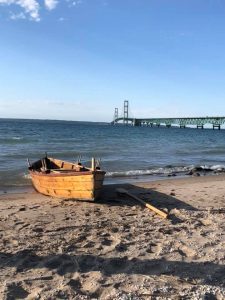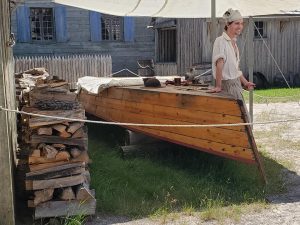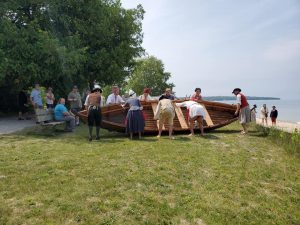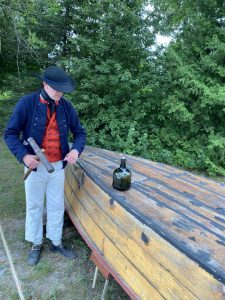 When thinking about the Great Lakes fur trade, most people will imagine French Canadian voyageurs paddling huge birchbark canoes filled with tons of furs or trade goods. Canoes were absolutely an integral part of the fur trade, and provided a vital link between Michilimackinac and other communities around the Great Lakes. However, they were by no means the only watercraft on the lakes, and a great deal of people and goods were moved by a type of large rowboat called a bateau.
When thinking about the Great Lakes fur trade, most people will imagine French Canadian voyageurs paddling huge birchbark canoes filled with tons of furs or trade goods. Canoes were absolutely an integral part of the fur trade, and provided a vital link between Michilimackinac and other communities around the Great Lakes. However, they were by no means the only watercraft on the lakes, and a great deal of people and goods were moved by a type of large rowboat called a bateau.
In the 18th century, there were few standardized plans for batteaux. Although the British Admiralty used a standard 30-foot design for vessels destined for military service in Canada, individual batteaux might range from less than 20 feet long to over 30, and there were regional variations in design. All shared a few common features: a flat bottom without a keel, heavier stems at the bow and stern, and butted plank construction. Relatively easy to build so long as appropriate woodworking tools were on hand, a bateau could be knocked together without the need for skill ship carpenters or shipyards. A bateau could be paddled, poled, or propelled under sail, but generally the vessels were powered by large wooden oars.
 While canoes (and sailing vessels) were absolutely workhorses of the Great Lakes in the 18th century, in many instances there were more batteaux on the lakes and rivers than other types of watercraft. In 1778, for example, 374 batteaux set out from Montreal for Michilimackinac and other western posts, while only 152 canoes left the city for the summer trading season. Individual merchants might own or hire several batteaux. Michilimackinac merchant John Askin, for instance, dispatched 10 batteaux in 1777, while trading partners Thomas Smith, William Taylor, and Edward Ripley sent 16 more to Detroit and Michilimackinac. A 1778 inventory of Askin’s estate included both a “Common batea[u]” and a “Small fish [bateau],” both presumably for personal use rather than heavy trade.
While canoes (and sailing vessels) were absolutely workhorses of the Great Lakes in the 18th century, in many instances there were more batteaux on the lakes and rivers than other types of watercraft. In 1778, for example, 374 batteaux set out from Montreal for Michilimackinac and other western posts, while only 152 canoes left the city for the summer trading season. Individual merchants might own or hire several batteaux. Michilimackinac merchant John Askin, for instance, dispatched 10 batteaux in 1777, while trading partners Thomas Smith, William Taylor, and Edward Ripley sent 16 more to Detroit and Michilimackinac. A 1778 inventory of Askin’s estate included both a “Common batea[u]” and a “Small fish [bateau],” both presumably for personal use rather than heavy trade.
 The British military also heavily employed batteaux to move personnel and supplies around the lakes and connect far-flung posts like Michilimackinac and Detroit. As somewhat disposable craft exposed to relatively heavy work, these batteaux required regular repair and maintenance. In 1771 Capt. George Turnbull received £85 for mending boats, making oars, and burning pitch at Michilimackinac. By 1778, Sergeant Amos Langdon of the 8th Regiment was issued nails from the engineer’s stores to repair the King’s batteaus and the wharf. Although somewhat more cumbersome than a canoe, a bateau could efficiently cover great distance at speed. In late September 1778, an express canoe traveled from Michilimackinac to Montreal in 10 to 14 days, while a batteau rowed by eight “active men” could go to the city and return to Michilimackinac by November 10, making a 6 week round trip. However, supplies to maintain the boats could be difficult to procure, making repairs difficult. In 1779, Major Arent DePeyster, Michilimackinac’s commanding officer, unsuccessfully requested pitch and oakum to repair batteaux. A year later, DePeyster sent pitch and oakum up from Detroit to repair the batteaus at Michilimackinac, telling Lt. Gov. Patrick Sinclair that these materials were previously hard to get. Boat repairs could be a thankless task. In 1774, Lt. Col. John Caldwell, commanding the 8th Regiment at Fort Niagara, complained that “The old ones [batteaus] have been so often repaired since I came here that it is throwing money away to attempt repairing them again.” Apparently the old adage about a boat being a hole in the water is somewhat older than expected.
The British military also heavily employed batteaux to move personnel and supplies around the lakes and connect far-flung posts like Michilimackinac and Detroit. As somewhat disposable craft exposed to relatively heavy work, these batteaux required regular repair and maintenance. In 1771 Capt. George Turnbull received £85 for mending boats, making oars, and burning pitch at Michilimackinac. By 1778, Sergeant Amos Langdon of the 8th Regiment was issued nails from the engineer’s stores to repair the King’s batteaus and the wharf. Although somewhat more cumbersome than a canoe, a bateau could efficiently cover great distance at speed. In late September 1778, an express canoe traveled from Michilimackinac to Montreal in 10 to 14 days, while a batteau rowed by eight “active men” could go to the city and return to Michilimackinac by November 10, making a 6 week round trip. However, supplies to maintain the boats could be difficult to procure, making repairs difficult. In 1779, Major Arent DePeyster, Michilimackinac’s commanding officer, unsuccessfully requested pitch and oakum to repair batteaux. A year later, DePeyster sent pitch and oakum up from Detroit to repair the batteaus at Michilimackinac, telling Lt. Gov. Patrick Sinclair that these materials were previously hard to get. Boat repairs could be a thankless task. In 1774, Lt. Col. John Caldwell, commanding the 8th Regiment at Fort Niagara, complained that “The old ones [batteaus] have been so often repaired since I came here that it is throwing money away to attempt repairing them again.” Apparently the old adage about a boat being a hole in the water is somewhat older than expected.
 Today, a 22-foot bateau is part of the small interpretive fleet at Colonial Michilimackinac (we also have a 28-foot north canoe and a 35-foot Montreal canoe). We use all of these vessels to interpret the vital relationship between Michilimackinac and the surrounding waters of the Great Lakes, and our interpretive staff maintains these boats and utilizes them for special events. This summer, we will have three Maritime Michilimackinac weekends focusing on the roles and chores of sailors, voyageurs, and others working to maintain Michilimackinac’s marine links to the outside world. Weather permitting, our staff will use our bateau and canoes to get out on the water, so we hope you’ll join us for these special events!
Today, a 22-foot bateau is part of the small interpretive fleet at Colonial Michilimackinac (we also have a 28-foot north canoe and a 35-foot Montreal canoe). We use all of these vessels to interpret the vital relationship between Michilimackinac and the surrounding waters of the Great Lakes, and our interpretive staff maintains these boats and utilizes them for special events. This summer, we will have three Maritime Michilimackinac weekends focusing on the roles and chores of sailors, voyageurs, and others working to maintain Michilimackinac’s marine links to the outside world. Weather permitting, our staff will use our bateau and canoes to get out on the water, so we hope you’ll join us for these special events!









